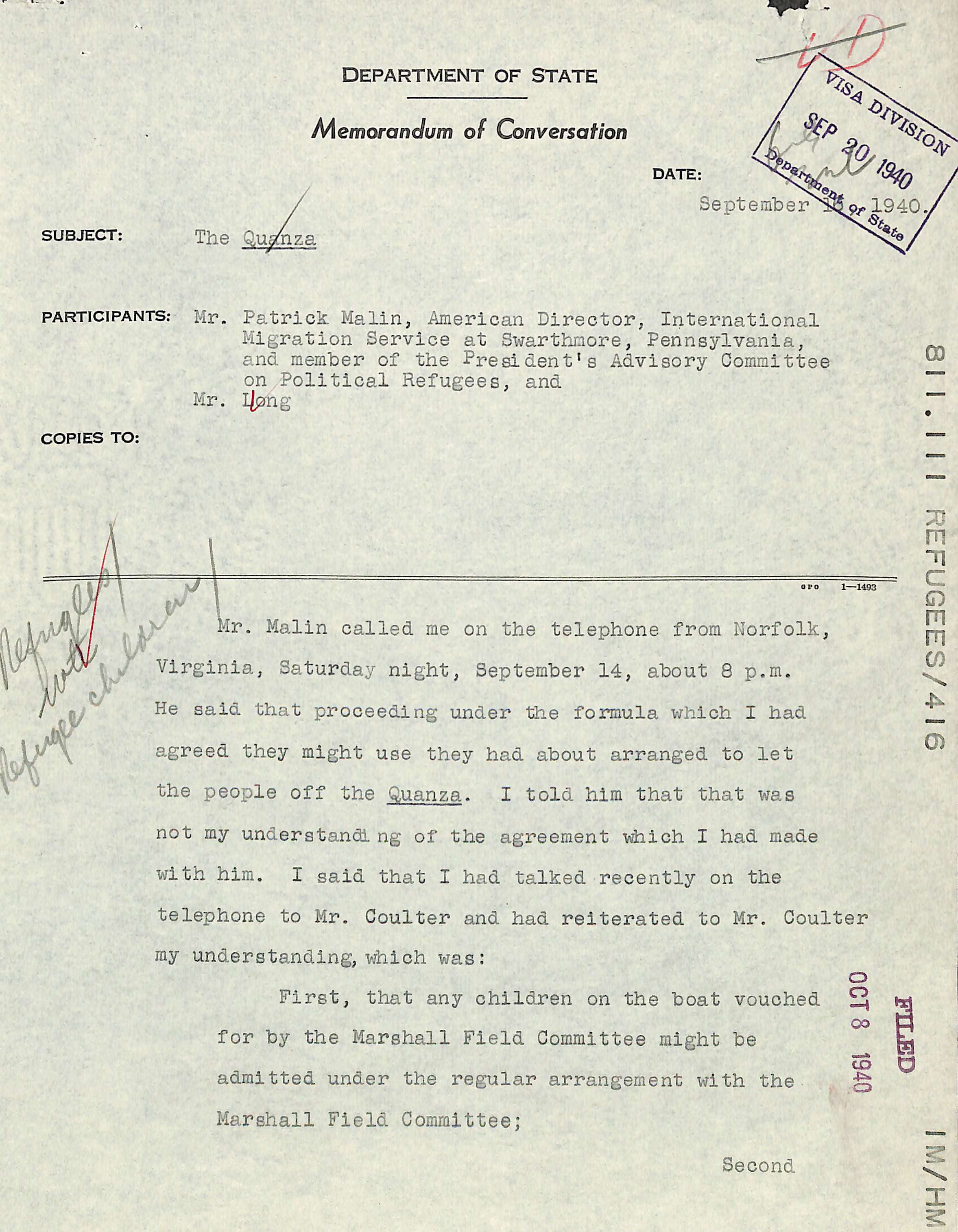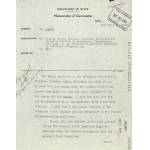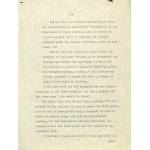State Department Memo Regarding Refugees Admitted to the United States
9/18/1940
Add to Favorites:
Add all page(s) of this document to activity:

Add only page 1 to activity:
Add only page 2 to activity:
Add only page 3 to activity:
This internal memorandum, written by Assistant Secretary of State Breckinridge Long, summarizes a telephone conversation between Long and Patrick Malin, a member of the President's Advisory Committee on Political Refugees, regarding war refugees aboard the steamship SS Quanza. Malin advocated that all the passengers be admitted to the United States, while Long could not agree to it and thought it would violate the law.
The Quanza was a Portuguese ship that sailed on August 8, 1940, from Lisbon, Portugal, bound for Veracruz, Mexico, with more than 300 passengers on board. Many of the passengers were Jewish refugees from Nazi-controlled Europe. Desperate to leave Europe, some of them carried forged visas for the United States and Mexico. When the ship arrived in New York on August 20, only 196 were allowed to disembark. When the remaining 121 arrived in Veracruz, the Mexican government would only admit the 35 whose visas they accepted as valid. The ship was ordered back to Europe with a stop in Norfolk, Virginia, to refuel. Hearing rumors that Portugal would refuse to accept the passengers, the State Department considered offering temporary visas based on an emergency clause in the Alien Registration Act of June 1940.
On September 11, the ship arrived in Norfolk. Panic among the passengers ensued, with one man jumping overboard to swim to shore (he was returned to the ship). Others wrote telegrams to President Franklin Roosevelt and First Lady Eleanor Roosevelt, begging them to intervene. A family aboard the Quanza hired Norfolk attorney Jacob L. Morewitz, who sued the Portuguese National Line for breach of contract. While the suit went to court, immigrant advocates lobbied the Government. The President’s Advisory Committee on Political Refugees interviewed the passengers; and all remaining passengers were permitted to enter the United States on September 15, 1940.
The Quanza was a Portuguese ship that sailed on August 8, 1940, from Lisbon, Portugal, bound for Veracruz, Mexico, with more than 300 passengers on board. Many of the passengers were Jewish refugees from Nazi-controlled Europe. Desperate to leave Europe, some of them carried forged visas for the United States and Mexico. When the ship arrived in New York on August 20, only 196 were allowed to disembark. When the remaining 121 arrived in Veracruz, the Mexican government would only admit the 35 whose visas they accepted as valid. The ship was ordered back to Europe with a stop in Norfolk, Virginia, to refuel. Hearing rumors that Portugal would refuse to accept the passengers, the State Department considered offering temporary visas based on an emergency clause in the Alien Registration Act of June 1940.
On September 11, the ship arrived in Norfolk. Panic among the passengers ensued, with one man jumping overboard to swim to shore (he was returned to the ship). Others wrote telegrams to President Franklin Roosevelt and First Lady Eleanor Roosevelt, begging them to intervene. A family aboard the Quanza hired Norfolk attorney Jacob L. Morewitz, who sued the Portuguese National Line for breach of contract. While the suit went to court, immigrant advocates lobbied the Government. The President’s Advisory Committee on Political Refugees interviewed the passengers; and all remaining passengers were permitted to enter the United States on September 15, 1940.
This primary source comes from the General Records of the Department of State.
Full Citation: State Department Memorandum of Conversation Regarding Refugees Aboard the SS Quanza Being Admitted to the United States; 9/18/1940; General Visa Correspondence, 1914 - 1949; General Records of the Department of State, Record Group 59; National Archives at College Park, College Park, MD. [Online Version, https://www.docsteach.org/documents/document/memo-refugees-admitted, April 23, 2024]Rights: Public Domain, Free of Known Copyright Restrictions. Learn more on our privacy and legal page.






